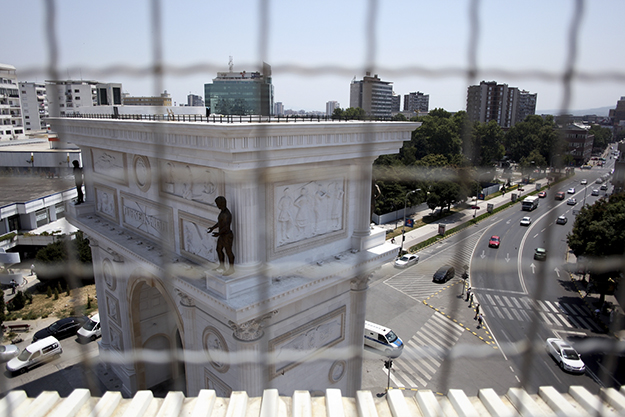Some find it grotesque and bizarre and have dubbed it ‘Europe’s capital of kitsch.’ Others have praised it for giving homage to the country’s many heroes and vibrant history. Either way, the new look of Skopje, Macedonia’s capital, is likely to turn heads and awe many, for better or worse.
‘Skopje 2014’ is the name of the architectural project, which was presented in 2010 and has radically changed the look of the city’s central area. Those visiting Skopje in 2015 will find a downtown area scattered with structures built in neo-baroque and neoclassical style: new buildings and facade makeovers of old ones, statues and monuments in honor of Macedonian national heroes, fountains, bridges, a triumphal arch and even a ferris wheel.
As the centerpiece of the revamp project, stands a 22 meter high statue of Alexander the Great facing another statue of his father Filip II. These two headline the process of rewiring national history and identity away from its Slavic, and onto its ancient, roots (so-called ‘antiquization’), in order to reclaim the history of ancient Macedonia and strengthen the national spirit of ethnic Macedonians.

As such, the project practically tells a brand new story of Skopje. After a tragic earthquake that erased most of the city in 1963, Skopje was rebuilt in a ‘brutalist’ style, which boasted massive concrete block buildings and wide open public spaces. Today, the new look of Skopje features baroque and classicist buildings and facades along with countless sculptures and monuments, which display a clear distancing from the history of the city. Moreover, they are the most recent buildings in the world with this style, seemingly out of place in 21st century Balkans.
Prime Minister Nikola Gruevski himself has publicly boasted that the project was his personal idea. A few of the telephone conversations leaked in this spring’s wiretapping affair revealed that this was not just an empty statement, as Gruevski handpicked the design of facades, balconies, building materials, and even the interior design of the city’s new double-decker buses.
However, ‘Skopje 2014’ is not only about esthetic makeovers. The bronze, marble and polystyrene of the new city look embody Macedonian politics today and are the signs of a democracy derailed. Unfortunately, the cost of this extends beyond finance alone.
A Lavish Makeover
When it was first presented to the general public in 2010, ‘Skopje 2014’ envisioned around 40 monuments, sculptures, facades and renovated buildings, with a total cost of around 80 million euros. Today in 2015, a year after the deadline for its completion, the number of objects has tripled and the total cost is estimated at somewhere between 578 million and 1 billion euros. To illustrate the scale of the project in the context of overall public procurement in Macedonia, аn astonishing one third of the100 biggest public procurement contracts (or 28 percent of the cost) between 2010 and 2014 have been related to aesthetic modifications and construction of buildings, building statues and monuments. In the context of Macedonia’s ever-sluggish economic performance, extreme unemployment rate (currently standing at 27.3 percent) and flabby infrastructure, this seems strange and problematic.
Moreover, such public spending seems to benefit a selected few, like the construction company DG Beton, which has been commissioned to buildpractically one third of the project. Similarly, artist Valentina Stevanovska, relatively unknown before her work in ‘Skopje 2014,’ is the author of most of the prominent structures of the project, including the statues of Alexander the Great and Fillip II, the triumphal arch and a number of other sculptures dispersed around the downtown area.
A Transparency International auditing report of the makeover project suggested various malpractices in the public procurement processes, as there were instances where dramatically more expensive bids were accepted, the costs of parts of the project were not clearly stated and could not be verified, along with instances of clear interference of the central government with the powers of the local government.

Finally, despite the hefty price tag, some structures of the project have already started to fail the test of time. Skopje still seems to be a work in progress, as most of the pillars featured in the new buildings are hollow and facades made of polystyrene cover the original facades of old buildings.
Hardline Politics
On top of the high financial cost, Skopje’s new look has come at a major political cost. Instead of opening up a public debate, city planning has been narrowed down to press conferences by city and government officials on one side and citizen protests on the other. The two sides lack interaction and hardly overlap.
As a result, since its very inception, the project has faced significant opposition in the civil society sector. In 2009, a group of civil activists gathered in the city square to protest against the city’s plan to build a church in the central square. In response, protesters were beaten up by a group of conservative supporters of the project. Even though the police and media were present, unfortunately no one has been held accountable ever since.
In another citizen initiative, the activists, who camped in a small park in the central area to prevent the green area from being replaced with a new government building, were arrested and taken away by the police; soon after construction works began on the spot. The initiative ‘Go sakam GTC!’ / ’I love the City Shopping Center!’ which sought to prevent plans for a makeover of the facade of the city shopping center hosted massive flash-mobs and organized a municipal referendum against the plan. Although the referendum was not ultimately successful, it stands as the only local referendum ever administered in Macedonia, and displayed the dissatisfaction of a good number of local residents.
The latest of the myriad of civil initiatives which try to find their way into the public debate gathers against the plans to build a ferris wheel on the banks of the Vardar River. “Skopje is no Disneyland!” reads their slogan and last week they protested to remind city planners of their accountability before the citizens of Skopje.
Sanja Mihajlovic, one of the organizers of the protest, called ‘Skopje 2014’ an “ideological Disneyland,” suggesting that the project was an attempt to spread nationalism and divert public attention away from pertinent social problems. Some of the protesters confessed that they even avoid walking around the city square, where most of the objects of ‘Skopje 2014’ are located, because they cannot identify with the new look of the city. Others suggested that the 19 million euros allocated for the ferris wheel would be wisely spent to address the cases of more than 300 citizens who need expensive medical treatment that they cannot afford.
Few are optimistic about the odds of the initiative against the city planners. However, the limited impact of such initiatives display a broken public dialogue and city planning which fails to comply with the standards of inclusive policy making. More than anything, such broken public dialogue bears the cost of excluding sections of the society and dissolving the social glue, which in heterogeneous societies like Macedonia, is more important than anywhere else.
Skopje 2015: A City Divided
Beyond the facades, buildings and monuments featured in ‘Skopje 2014’ is the narrative of re-telling and re-claiming parts of national history which have been detached from Macedonian national identity across centuries of history filled with turmoil and contestation. In the case of Macedonia, such revival has come in spite of the country’s abiding feud with Greeceover the rights to the name of Macedonia and the ancient history linked with the region. Moreover, in the context of Macedonian politics, which largely operates through ethnic camps, ‘Skopje 2014’ is a statement by the majority to back up the pervasive nationalistic rhetoric by occupying the central public space.
It has been precisely such rhetoric that has enabled the ruling right-wing coalition of the ethnic Macedonian VMRO-DPMNE and the ethnic Albanian Democratic Union for Integration (DUI) to hold their position of power for almost a decade. At the root of this approach is the division of society members into “patriots” and “traitors,” based on the governing elite’s self-perception as the only legitimate protectors of the interests of their ethnic community. Moreover, in the context of Skopje’s socialist past, embodied through the distinctive architectural style prevalent before ‘Skopje 2014,’ the city makeover is also about abolishing that part of the city’s history and isolating former socialist, and current liberal, intellectual elites. Thus, a project as radical and transformative as ‘Skopje 2014’ has been made possible by imposing such divisions and by creating ethnic and ideological outsiders.
In the midst of the current deep political crisis in the country, it is difficult to say what the future holds for Skopje’s new look. However, it is safe to say that the outcome of the crisis is likely to determine whether Skopje will grow into its new look or whether it will open the way for yet another makeover.K

